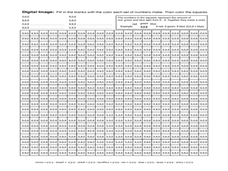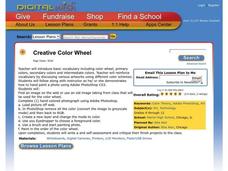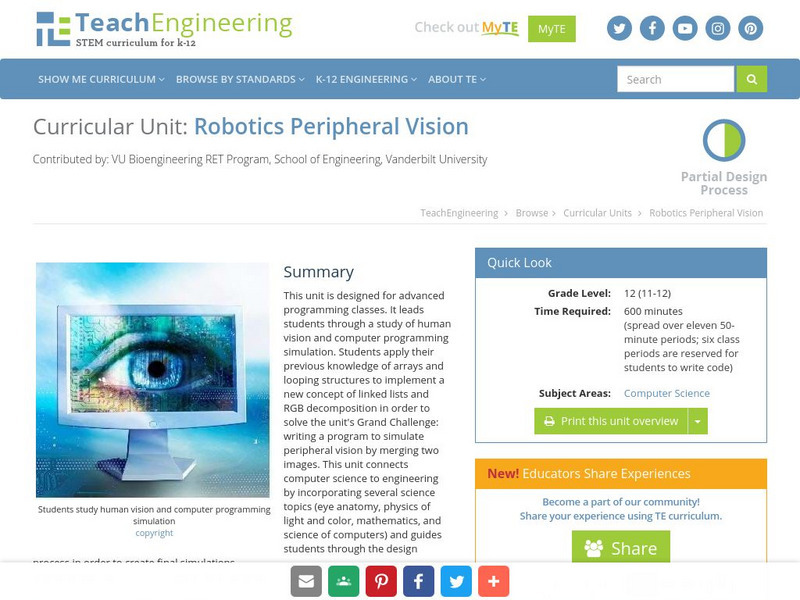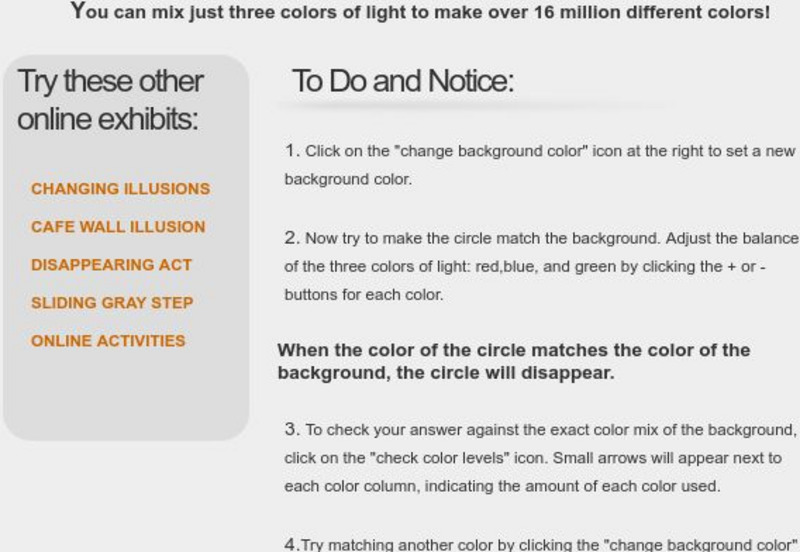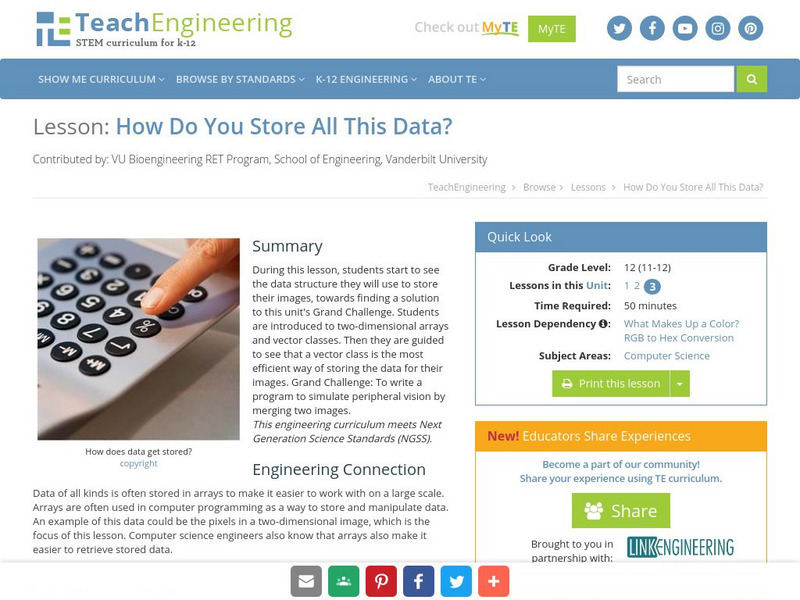Curated OER
Color
For this color worksheet, students read about light, prisms, the RGB model and the CMYK model. Students match colors with their definition, they draw the color chart, they apply the RGB and CMYK models to make colors and they interpret...
Code.org
Encoding Color Images
Color me green. The fourth lesson in a unit of 15 introduces the class to color images and how to encode color images using binary code and hexadecimal numbers — and they will quickly notice that it is easier to code the...
PBS
Passion for Pixels
Picture this: a fun activity for pupils to discover pixels. After learning about digital signals and pixels, scholars act as senders and receivers of an image. The sender indicates zero or one to tell whether each square in a grid is...
CK-12 Foundation
Rose Colored Glasses
How can we change the color of what we are seeing? The simulation allows individuals to change the color of a car's paint, the color of light pointed at the car, and the color of glasses the person is wearing. Each combination creates a...
Curated OER
Imagers: The Adventure of Echo the Bat Number to Pictures: How Satellite Images are Created
Students examine the three primary colors of light and design a numerical code to represent those colors. They tell how satellites use numbers to create satellite images after completing a number of experimental activities.
Curated OER
Solar System
Explore the solar system in detail, from it's origins to its components. Visual data gathered by actual space missions has been used to create the images and animations on each page of this stellar electronic book about the solar...
Code.org
Encoding B and W Images
Imagine drawing with zeros and ones. The third lesson in a unit of 15 introduces the class to creating black and white images. Pairs get together to create an encoding scheme in order to make these images. They move on to a...
Curated OER
Color
In this color worksheet, students read where light comes from and the different colors created through a prism. Students compare light (additive color) with pigments (subtractive color). Then students complete 1 drawing, 6 matching, 22...
Curated OER
HW Unit10:8- Color
In this color activity, high schoolers answer 16 questions about light, color and wavelength. They label a graph of position vs. displacement and answer questions about the graph including finding the frequency, amplitude, and wavelength.
Curated OER
Experiencing 3D
Students explore photography by utilizing digital cameras. In this 3 dimensional lesson, students create eye glasses using red and blue acetate in order to view 3-D images. Students utilize computers and digital cameras to enhance...
Curated OER
Georgia O'Keefe Inspired Flowers
Students examine artwork by Georgia O'Keefe. They create their own abstracted flower. They use multimedia applications to manipulate and filter the colors.
Curated OER
Creative Color Wheel
High schoolers explore graphic design by using color wheels to color images. In this art analysis lesson, students utilize Adobe Photoshop to experiment with coloring old images and removing all color as well. High schoolers...
Curated OER
Colorful and Textured Backgrounds
Learners create a solid color background for a web page. They calculate the hexadecimal code for a color value. They change the color of text and hypertext link items. They create a textured background from a graphic file.
Curated OER
Daily Lesson Plan # 9
Students review materials covered in previous class. They continue the tutorial in the textbook "Creative HTML Design", chapter 4, pages 78-83. Students work with browser safe colors. They open the CD that came with their textbook,...
TeachEngineering
Teach Engineering: Rgb to Hex Conversion
Students practice converting between RGB and hexadecimal (hex) formats. They learn about mixing primary colors in order to get the full spectrum of colors and how to average pixel values.
TeachEngineering
Teach Engineering: What Makes Up a Color?
As a part of the research and revise step of the Legacy Cycle, this lesson provides students with information they will need later on to be able to average pixels to simulate blurring in the peripheral plane of vision. Students learn why...
Science Buddies
Science Buddies: Color Profiles
Did you know that the same digital photo you see on a computer monitor may not look as good in print? When it comes to color profiles, there are a lot of options: RGB, CMYK, grayscale and indexed color are just a few. Learn how to choose...
TeachEngineering
Teach Engineering: Robotics Peripheral Vision
This unit is designed for advanced programming classes. It leads students through a study of human vision and computer programming simulation. Students apply their previous knowledge of arrays and looping structures to implement a new...
University of Colorado
University of Colorado: Physics 2000: Einstein's Legacy: Laptop Screens
A series of seven pages that describe how screen displays on laptop computers work using polarized light in a liquid crystal display. Interactive Java applets.
Exploratorium
Exploratorium: Online Exhibit: Mix and Match
A Shockwave movie which allows users to mix varying colors of light and observe the effect upon the appearance of a circle. Accompanied by a "To Do and Notice" section and a "What's Going On?" section. Excellent!
TeachEngineering
Teach Engineering: How Do You Store All This Data?
During this lesson, students start to see the data structure they will use to store their images, towards finding a solution to this unit's Grand Challenge. Students are introduced to two-dimensional arrays and vector classes. Then they...
University of Colorado
University of Colorado: Physics 2000: Temperature and Absolute Zero
A thorough, multipage discussion of color and color television sets that explains how an image is formed on the television using red, green, and blue light. Understandable discussion, excellent graphics, and many interactive Java applets.
Other
University of Edinburgh: Glossary of Introductory Computer Graphics Terms
This website, from the University of Edinburgh, provides a lengthy glossary of computer graphics terms written by Olin Lathrop, author of "The Way Computer Graphics Work". This site provides simple definitions of basic terms; no graphics...
Purple Math
Purplemath: Number Bases: Introduction & Binary Numbers
The process of converting between different number bases is actually fairly simple, but the thinking behind it can seem a bit confusing at first. And while the topic of different bases may seem somewhat pointless to you, the rise of...




